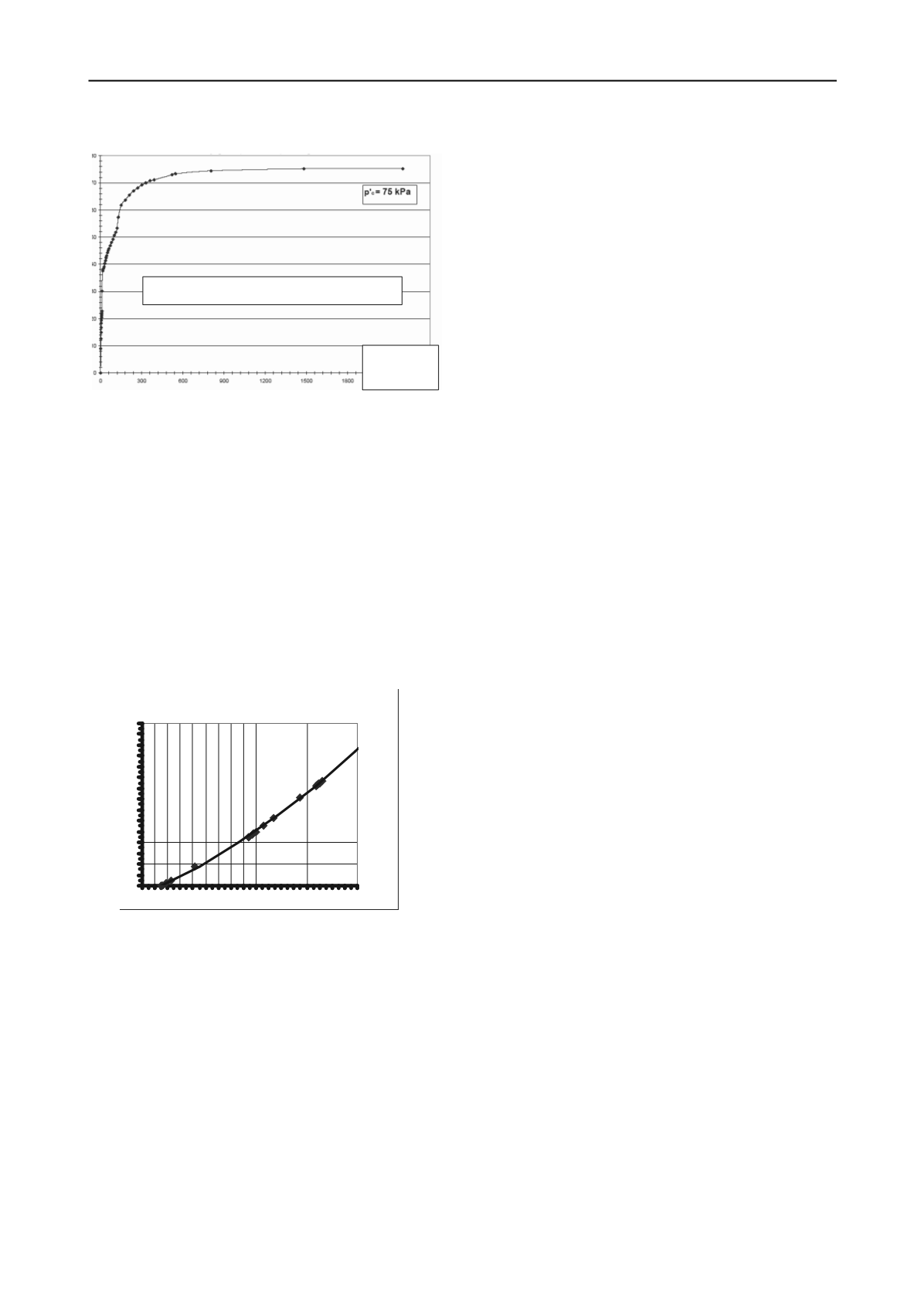
376
Proceedings of the 18
th
International Conference on Soil Mechanics and Geotechnical Engineering, Paris 2013
Figure 8. Progress of the expansive clay swelling pressure in time.
Characteristics obtained of the progress of potential
volumetric change in the examined clays in relation to the
humidity condition are presented see Figure 9. The dependence
between the swelling index and humidity can be written down
in a general form:
Vp = f(w)
(4)
where:
Vp
–
swelling index,
w
–
humidity.
Vp=(h
k
–
h
o
) : h
o
(5)
The function form of the potential expansiveness change
characteristics for the examined clay with statistical significance
Rxy
= 0.912 is as follows:
Vp = 3E-05w
3
+ 0,011w
2
+ 0,102w - 5,867 (6)
Fig. 9. Dependence of the swelling index
–
Vp,
on the swelling
expansive clay humidity -
w.
The characteristics of dependence of the swelling index in
relation to humidity, as presented in Fig. 9, allows one to
determine the progress and expansiveness phase characteristics
as well as changes in clay deformation values during swelling.
Knowing the final swelling humidity of a particular clay
w
k
, and
anticipating the direction of the humidity change on the basis of
initial humidity
w
o
, we know that one expansiveness phase will
occur, i.e.
(+
w
)
–
humidity increase
–
swelling phase, when
(-
w
) - drying
–
shrinkage phase.
Having the characteristics of potential volumetric changes
in relation to humidity as determined experimentally for a
particular type of clay, one can relatively easily forecast in
practice the range of substratum displacements.
A potential increase in the swelling clay volume can be
calculated from the obtained relationship (6) in the following
form:
Vp = Vp (w
o
)
–
Vp (w
k
)
(7)
For the case of humidity increase by value
w
=
(w
o
–
w
k
)
,
we will determine a positive swelling index
–
(+
V
p
)
in relation
to the positive condition on the basis of the swelling phase
characteristics.
In the clay shrinkage phase, during the swelled massif
drying, we obtain from the characteristics and calculations made
according to formula (7), a negative value
(-
V
p
)
–
shrinkage, in
relation to the initial state after the completed swelling, with
humidity
w
o
.
2 ENDING AND CONCLUSIONS
The results obtained enable forecasting building behaviours
in relation to determined natural fluctuations in the expansive
substratum humidity. On the basis of already conducted
expansiveness studies (25 cases) one can predict that for other
clays, material differences are related only to the range of limit
values, i.e. the limit of swelling contractibility and humidity (R
–
space), swelling index and swelling pressure, Kumor (2006).
When analysing the results obtained for numerical values of
expansiveness paramete
rs for the Poznań series
Neogen clays
from the northern Poland, one can describe them as very
cohesive, with a very high and extremely high plasticity as well
as a very high and extremely high swelling. They point to the
necessity for very careful forecasting of dislocations of
buildings when they are founded in expansive clays.
The presented results point to the need for determining
characteristics of potential expansiveness for various types of
clays, depending on humidity, swelling pressure as well as the
time and chemistry of the environment.
3 REFERENCES
Chen F.H. (1988): Foundations on Expansive Soils. Dev. In Geot. Eng.
Elsevier,
Amsterdam.
Danilov A.A. (1964): Grafik dla rozdelenia gruntov na obuhnye,
prosadochnye i nabukhajushhie.
Osn. Fund. i Mekh. Gruntov,
5: pp.
26-26.
Kumor M.K., (2006): Investigation of shrinkage-swelling of clays as the
potential tool to predict deformation of expansive subsoil.
XIV
Krajowa Konferencja Mechaniki Gruntów i Inżynierii
Geotechnicznej,
(in Polish) Białystok, Vol. 1,
pp. 234-242.
Niedzielski A., (1993): Factors Determinig swelling Pressure and Free
Swelling of Posnanian and Varved Clays.
Rozprawy Akademia
Rolnicza zeszyt nr 238,
Poznań.
Niedzielski A., Kumor M.K., (2009): Geotechnical Problems of a
Foudation on Expansive Soils in Poland.
Inzynieria Morska i
Geotechnika 3/2009,
(in Polish), pp. 180-190.
Przystański J., and all, (1991): Foundation on Expansive Soils, (In
Polish)
Zeszyt Politechniki Poznańskiej Rozprawy 224,
Po
znań.
Sorochan E.A. (1974): Stroitelstvo Sooruzenijj na Nabukhajushhikh
Gruntach. Stroizdat, Moskva.
Laboratory test
–
swelling pressure p
c
= f(t)
Time (h))
0
2
4
6
8
10
12
14
16
18
20
22
24
26
28
30
16 18 202224 2628303234363840 42444648 50
w [%]
Vp [%]


